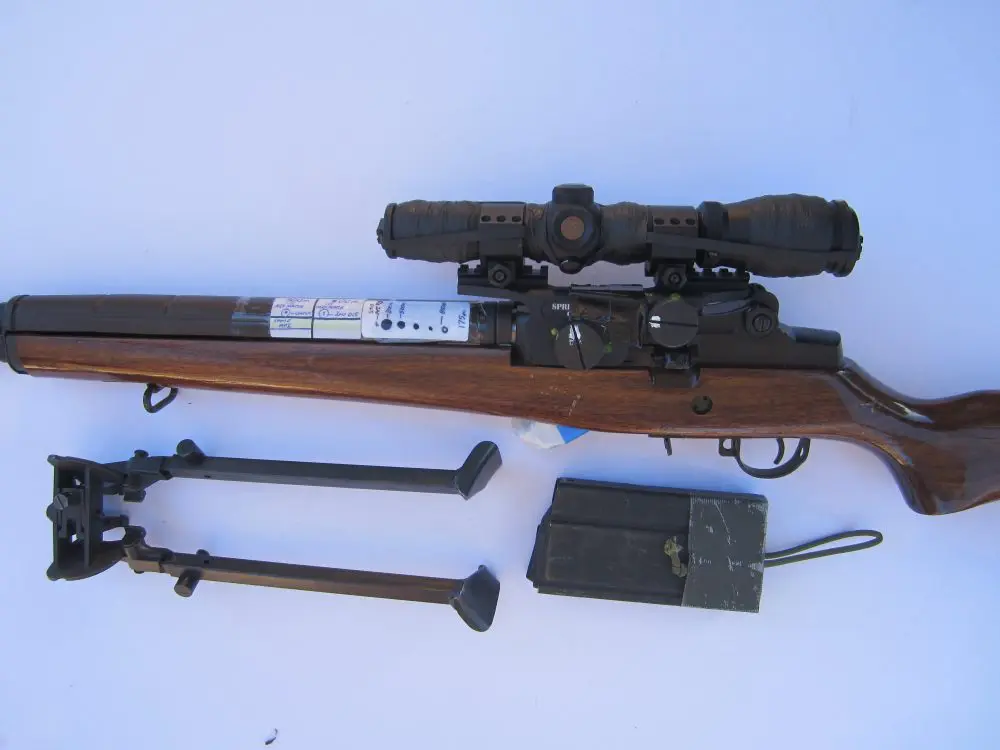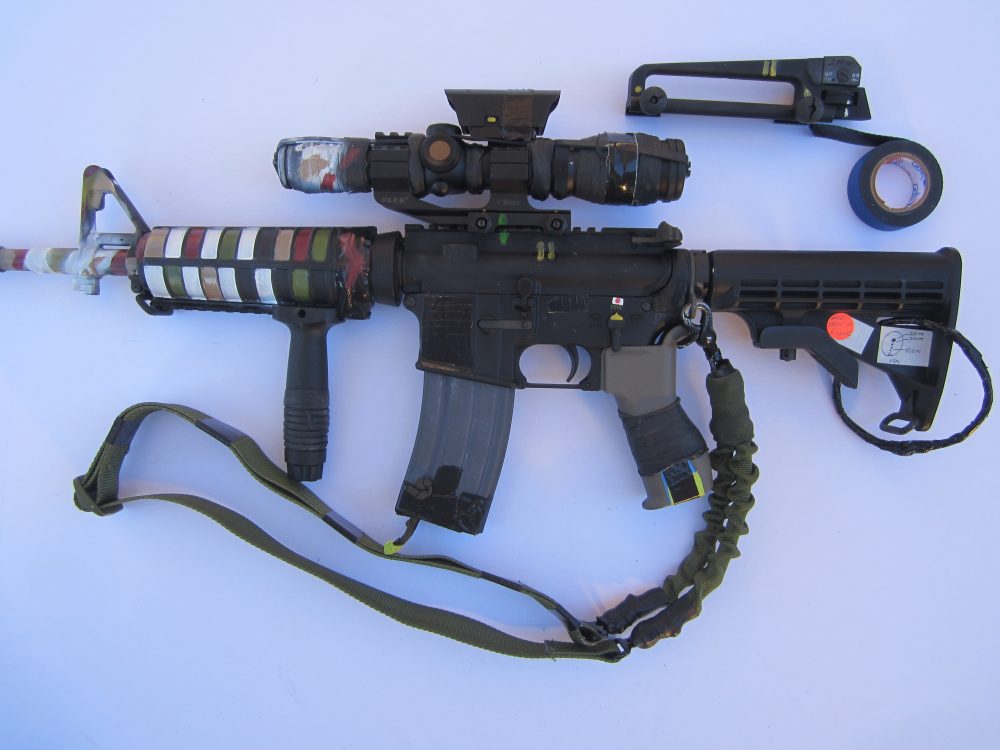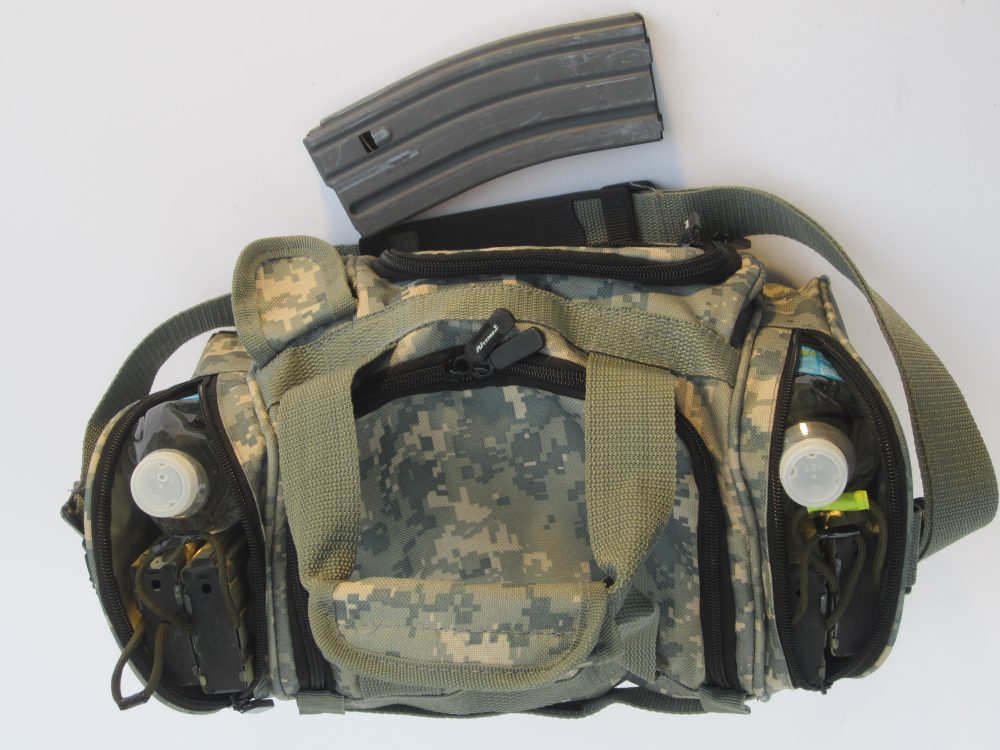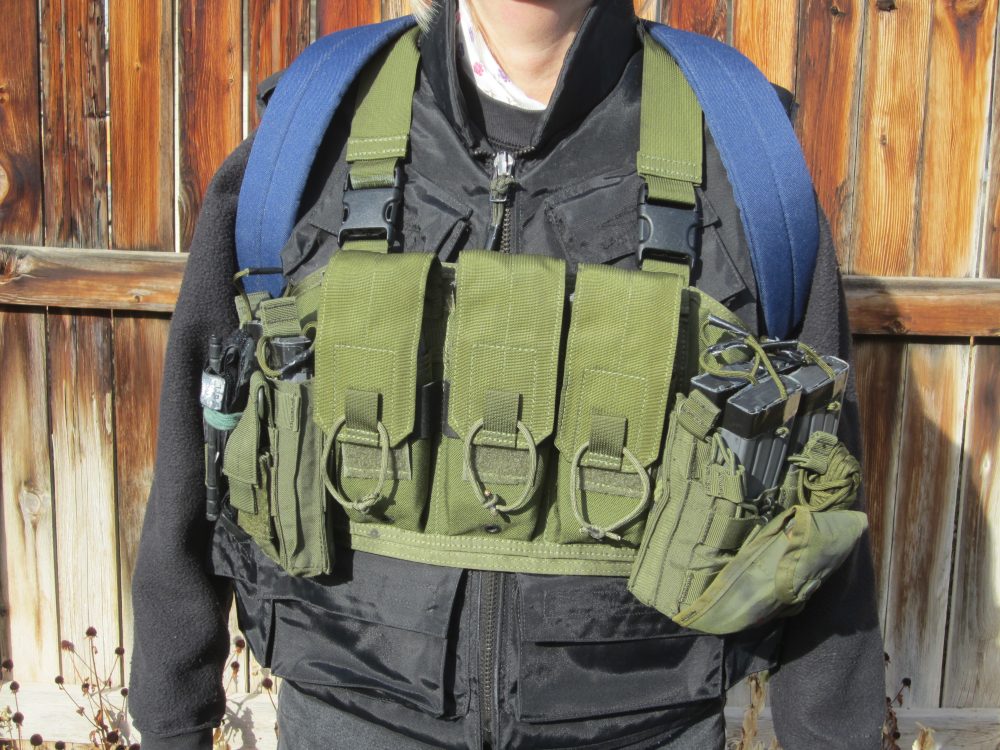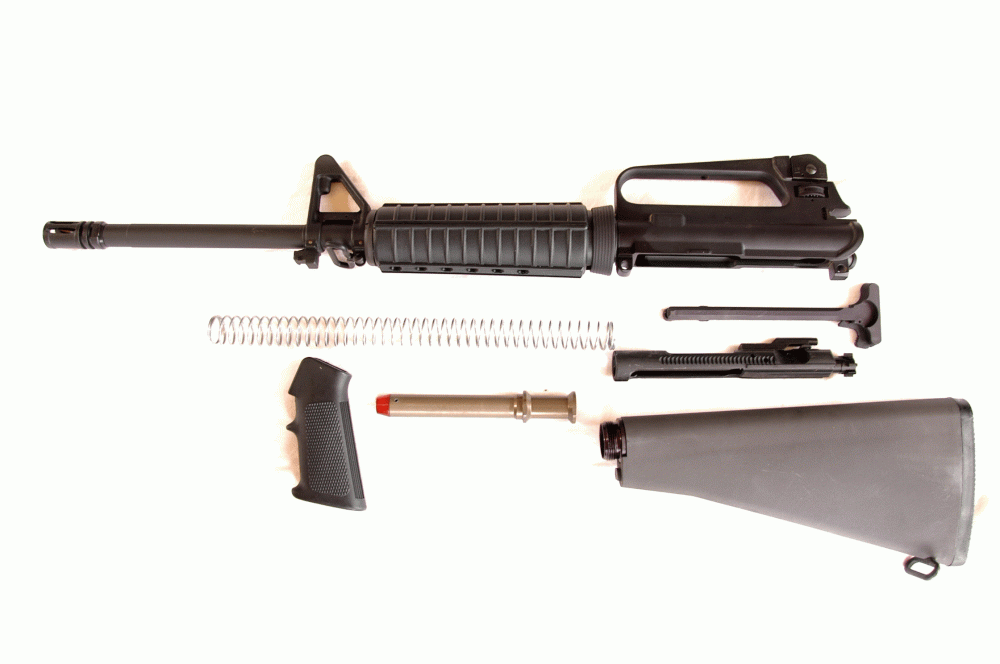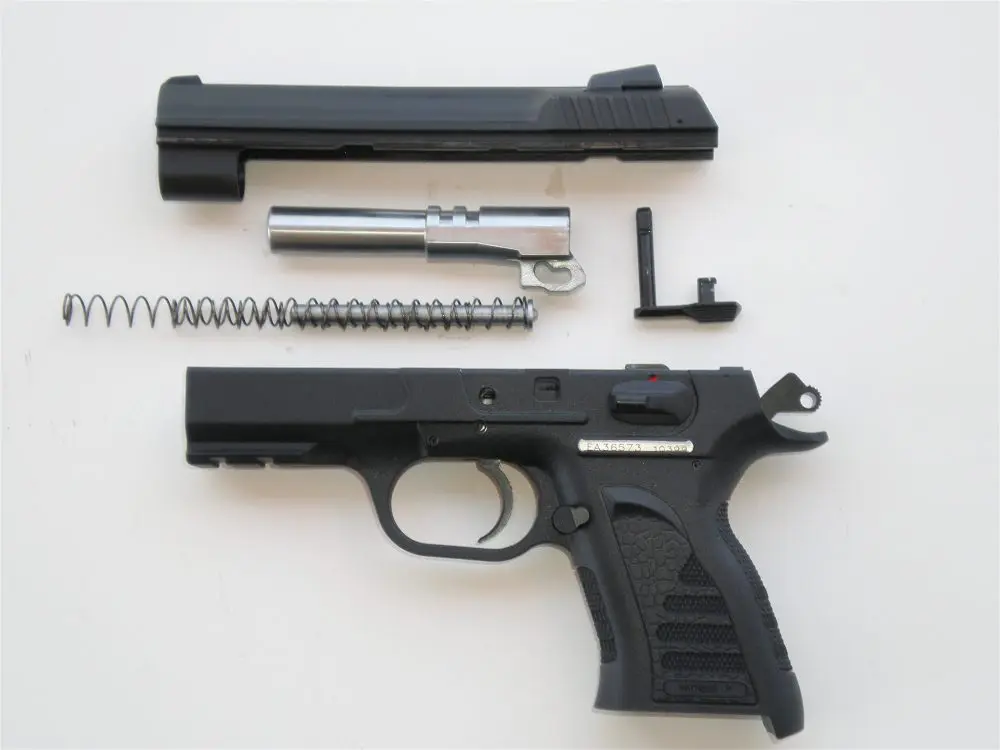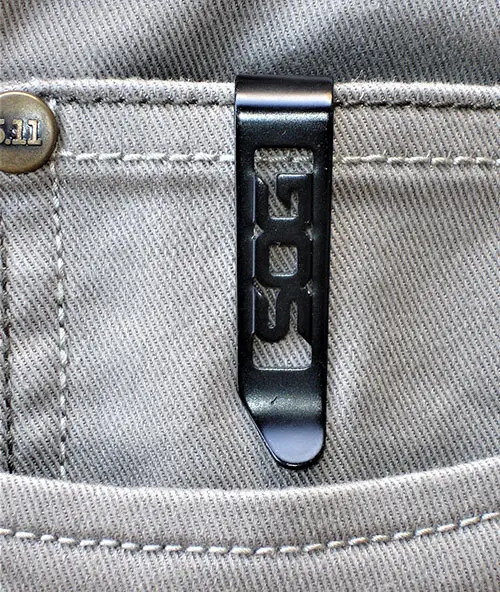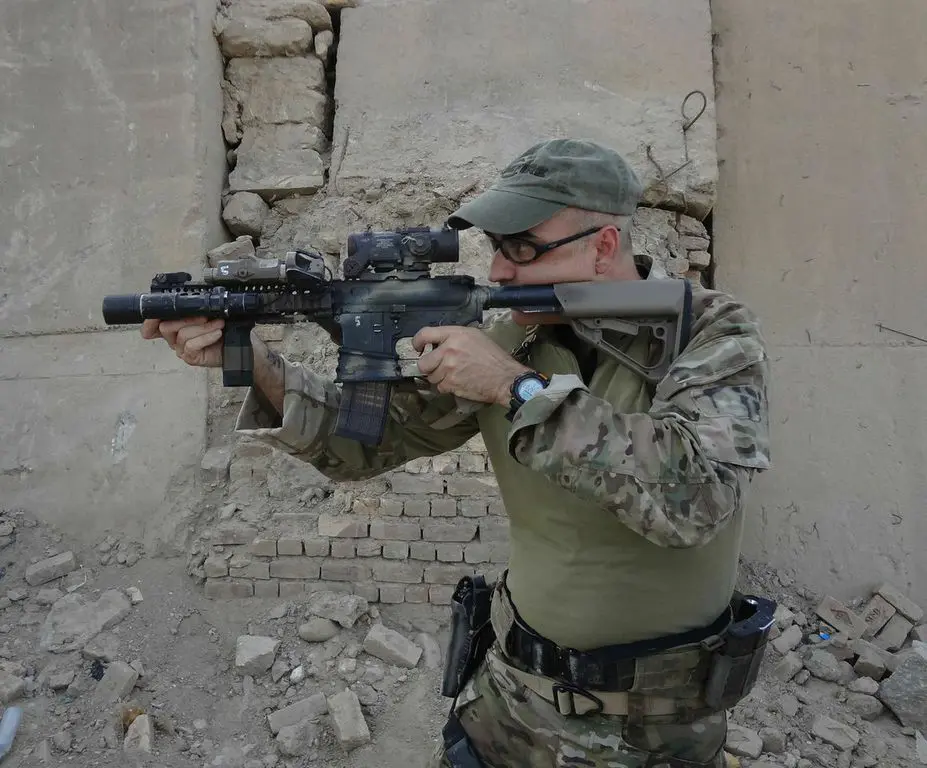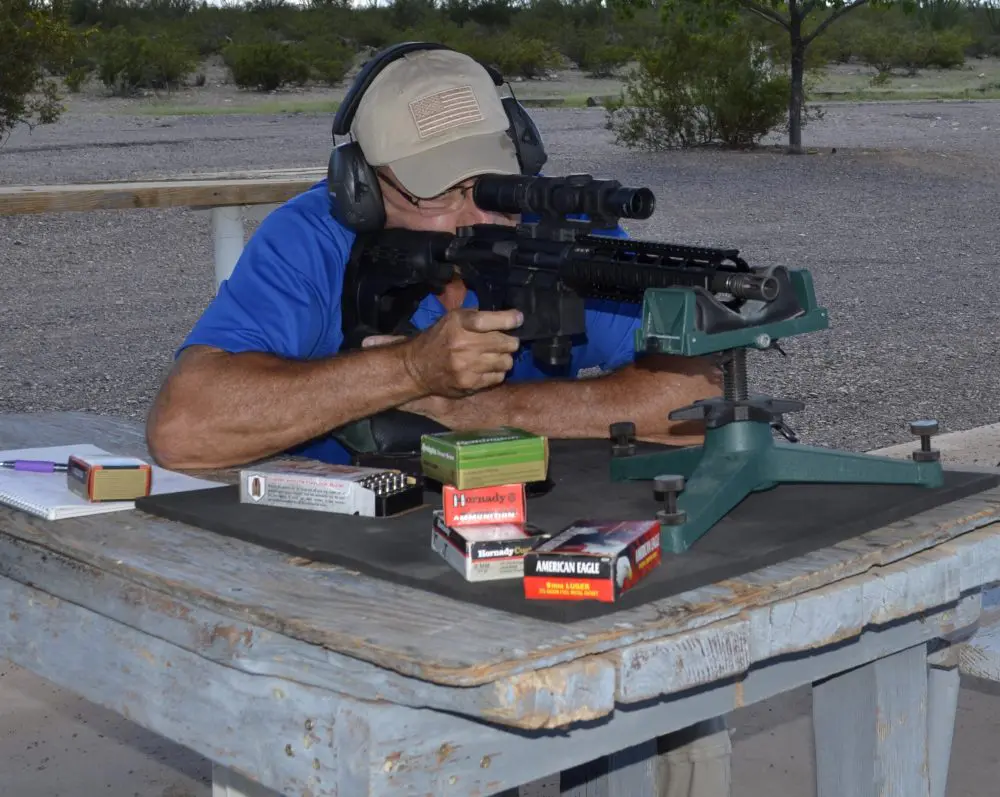Springfield M1A with rubber-wrapped Burris tactical scope. Detailed scope hold-overs and settings are on handguard with data for several types of .308 ammunition. If needed, quick camo job can be applied with spray paint. Extra batteries and ear plugs are stored in magazine well.
This is written for apocalyptic times, when open combat might be present in our country. It could happen as a result of an attack on our Constitution by an out-of-control president, a nuclear event, pandemic, geothermal event, or EMP. Regardless, things will get unfriendly quickly.
Aside from your food, water, and shelter preparation, what can you do to effectively move and operate in this environment? For brevity, I will focus on the AR-15 platform, but the elements can apply to most other firearms when your fellow citizens and well-meaning local authorities could become an active enemy. It has happened many times in many countries.
Initially folks will work together, but as time passes (it took just three days in New Orleans after Hurricane Katrina), bonds will fall apart as people get desperate for necessities. America’s citizenry has never been tested as Europe was during World Wars I and II. The majority of our population has never been tested in much of anything, let alone events that will quickly result in desperate and hostile people.
So for localized movement and survival in this mess, what might be best and for what reasons?
AR with rubber-wrapped Burris 1-4X tactical scope, single-point sling, 550-cord butt loop for hands-free carry hooked to a vest carabiner, heavy-duty charging handle, adjustable Accu-Grip with spare ear plugs and batteries inside, small Picatinny rail, and vertical forend grip. Unusual dazzle paint scheme visually breaks up rifle’s profile. Pre-zeroed alignment reference points are noted on carry handle and sight should scope need to be replaced.
Table of Contents
THE HEAT
A big fat .338 Lapua Magnum will do the job if you’re into killing small planets. But it and calibers like .300 Win Mag for survival or urban warfare are impractical. Our highly trained military snipers have plenty of heavy-duty backup, tech support, ammo, and supplies—you won’t.
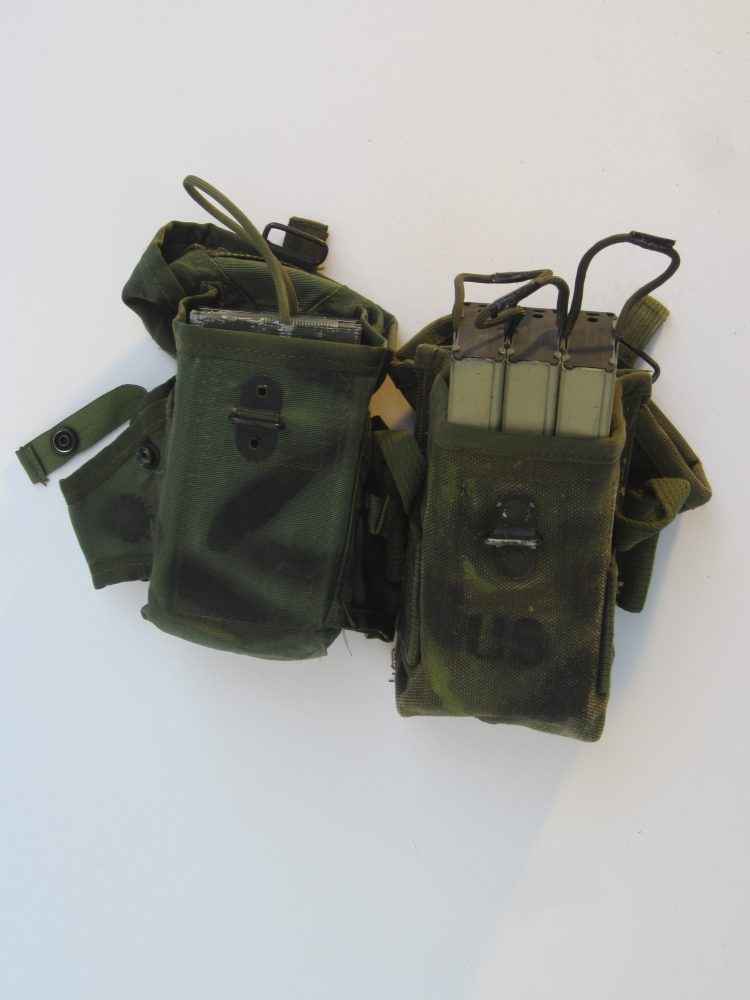
A high percentage of the shoot-or-die situations citizens in apocalyptic times face will be under 300 yards. Many folks don’t realize the prior planning necessary to get equipped properly.
For example, a trusty AR-15 with three to four magazines and 150 rounds of ammunition are a good start, but what can you do to make that more affordable and make your movement in the crisis more efficient?
Let’s talk firearms first. Fancy bells and whistles will fail over time—guaranteed! Stay as basic as you can. A semi-auto is better than a bolt-action rifle should you need to deliver some fire volume to get out of a mess.
The best calibers for this potential disaster are military: .223/5.56, .308/7.62, 30-06/.30 Cal, and 7.62×39. Do not underestimate a 12 gauge, which with slugs, 00, or number 4 buck can be bad news out to 125 yards.
Best handgun calibers are .38 Special, .357 Magnum, and 9mm Parabellum, because you can affordably stock up on ammo or maybe locate some when the poop hits the fan. The .22 LR is wonderful for survival, but not this kind of combative survival—but I still would not like to be shot with one!
SIGHTS AND OPTICS
Target-type sights and high-magnification scopes are not practical for real rattle-battle. Depending on your wallet and thinking, I recommend staying under 6X … you may find that 4x is the most realistic. Various military-type sights are good but expensive and some require batteries—think long term. Same goes for the 10-20X specialized sniper scopes.
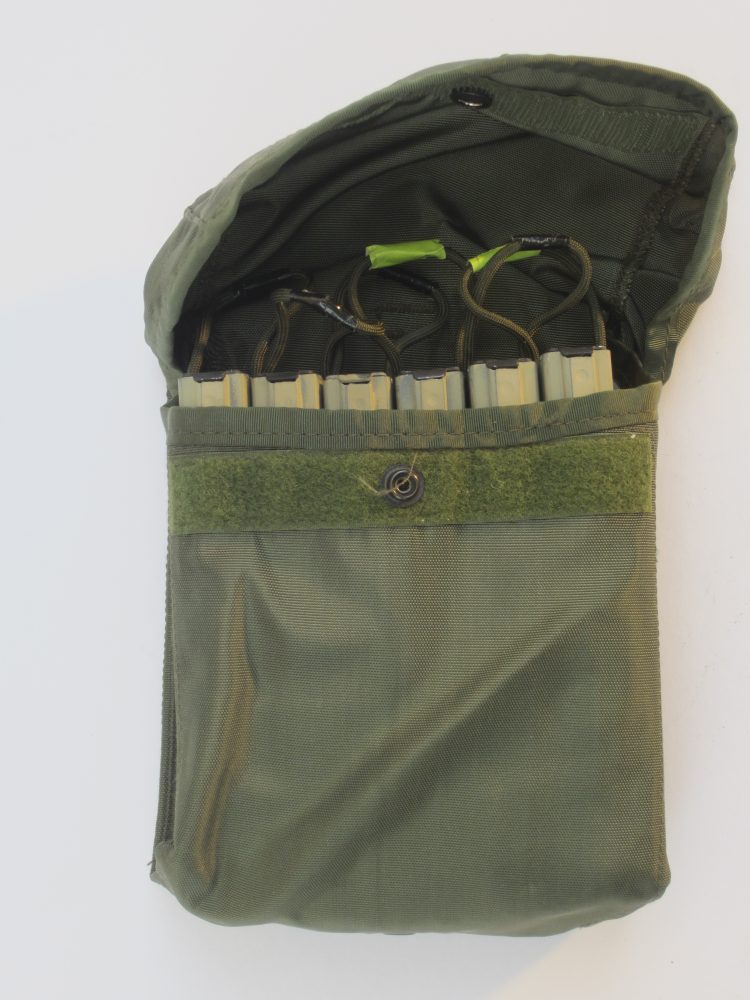
I like simple optics and favor one in particular—the Burris 1-4X Fullfield TAC30. It is affordable, designed for serious work, and has an easy-to-see variable-brightness illuminated red reticle when needed.
When turned off or no more batteries are available, it still has a permanent black reticle. It has uncluttered reference points for hold-overs, if you care to go to the range to verify. The 1-2X setting allows for CQB work and the 3-4X works fine for longer shots. I have used mine from 15 to 1,000 yards.
To further protect any scope, try wrapping it with several layers of elastic self-vulcanizing rubberized tape (available in hardware-store electrical aisles). This creates a thick layer of rubberized armor to protect your scope from non-fatal bumps and hits.
If your gun has iron sights, get it zeroed with them. And keep range hold-over information taped to your rifle stock for the various types of ammunition you have.
AMMUNITION
You can’t have too many magazines or too much ammunition. At a minimum I recommend at least ten magazines per gun and the necessary ammunition to initially load (charge them, for the purist) them at least once. Without plenty of ammo in this scenario and a way to utilize it quickly, you have a problem! A battlefield-proven trick is to first load three or four tracer rounds into your magazines and top off with your regular ammo. In a hot fight when you see the tracers, you’re coming up short and need to prepare to reload.
About tactics: some shooters practice partial-reload magazine drills or will not drop an empty magazine on the ground. Shoot the thing empty, reload, and get back in the fight. Your greatest concern is to win or escape the current fight, not to worry about empty or partially loaded magazines for tomorrow.
Small butt/shoulder packs are excellent for reaction use. This small one is filled with six 30-round magazines, water, energy snacks, first-aid supplies, knife, light, and 55-cord-bag. Pack cost just $15.
Partial mag changes look nifty in articles. A gunfight is different. Farting around switching out and pocketing partial magazines, trying to count shots, or saving empty magazines by carefully pocketing them are distractions when your “target” is trying to kill you.
If you win the fight, you can pick up your empty magazines afterward. If you lose, your opponent will appreciate your partially loaded and pocketed empty magazines. This is another reason why more magazines are better.
PRIMARY AND SECONDARY GEAR
The best bet for carrying magazines and ammo is an uncomplicated vest, military magazine pouches, old-style canteen cases, or a combination of the above.
You need a way to effectively carry enough ammunition for trouble. Bulky SWAT-like vests with many pockets can be problematic for several reasons, such as heat, weight, and moving quickly. Many are cluttered with loops for shot shells, pockets and pouches for rifle and pistol ammo, knives, lights, wedges, cord, first aid, radio, cell phone, television set, beer, and pretzels.
Low-bulk CQB Solution vest augmented with extra pouches holds nine magazines. Set up for a right-handed shooter, it also holds small light, utility knife, 550-cord, first aid and bleeding control. Retain this unit after jettisoning the larger backpack in an emergency.
Sure, macho-looking SWAT teams wear all this junk for what they are doing, but their event area and encounter time are small and short compared to yours, which may be miles and days, weeks or months.
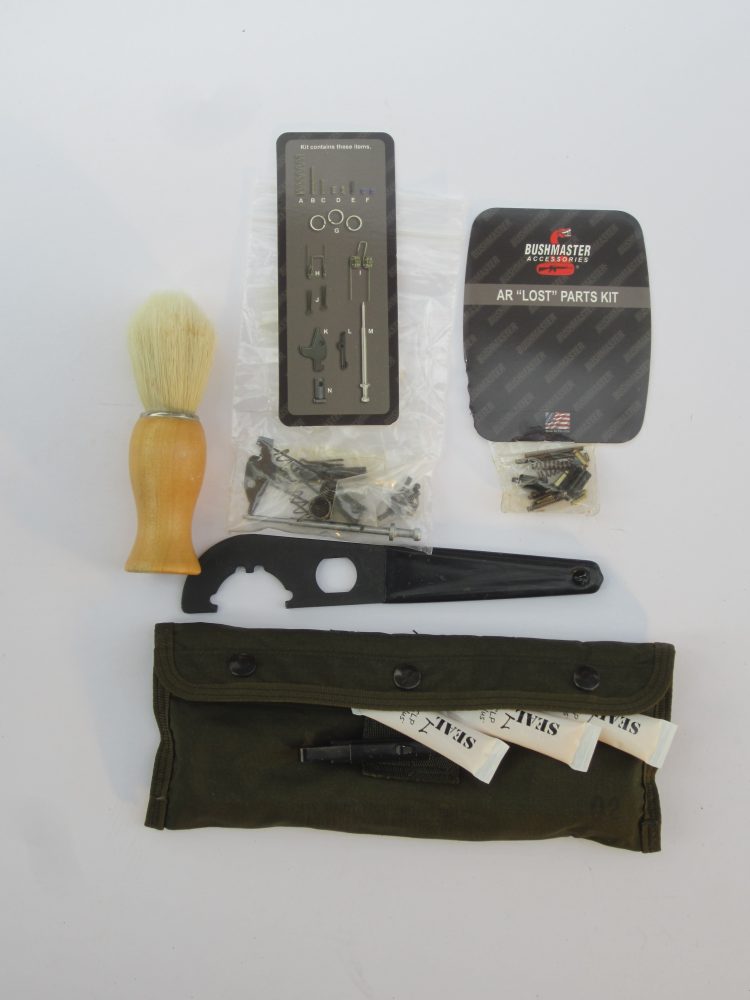
Rig your gear for reaction. Your secondary gear might be a backpack to carry essentials such as food, water, bedding, and cooking gear. Your primary gear is designed to immediately help save your life. This kit is possibly a vest or belt system with your immediate-action gear such as enough magazines and water for a hostile encounter.
In an emergency action, you can dump the heavy main pack and retain magazines, water, and short-term supplies to fight your way out of instant trouble. When all is done, you can recover your bulky stuff if you’re alive. Loaded down and trying to shoot, scoot, and get good cover with a 40-pound backpack is a game for dead people or supported infantry, but not so good for a 35+ year-old citizen who’s out of shape and sapped of energy.
Setting up your quick-reaction gear vest or kit correctly is essential. Consider: extra ear plugs because any guy over 50 will go permanently deaf around gun fire, prescription medicine, trauma/first-aid gear, 50 feet of 550 cord, carabiner, water, gloves, high-energy snacks, and utility pocket knife, plus a minimum of 180 rounds of AR magazine charged ammunition or 120 rounds of .30 caliber for this kit.
Personally I won’t pack a handgun, holster, and ammunition with their extra weight and bulk. I never carried a handgun in the military, and less than 25 of the last 100,000 enemy killed in the Middle East have been by handguns.
This lightweight tactical kit facilitates improved shooting on the run maneuverability. If I win the fight, I can retrieve my jettisoned main pack and possibly the other guy’s stuff too. If I lose, it won’t matter.
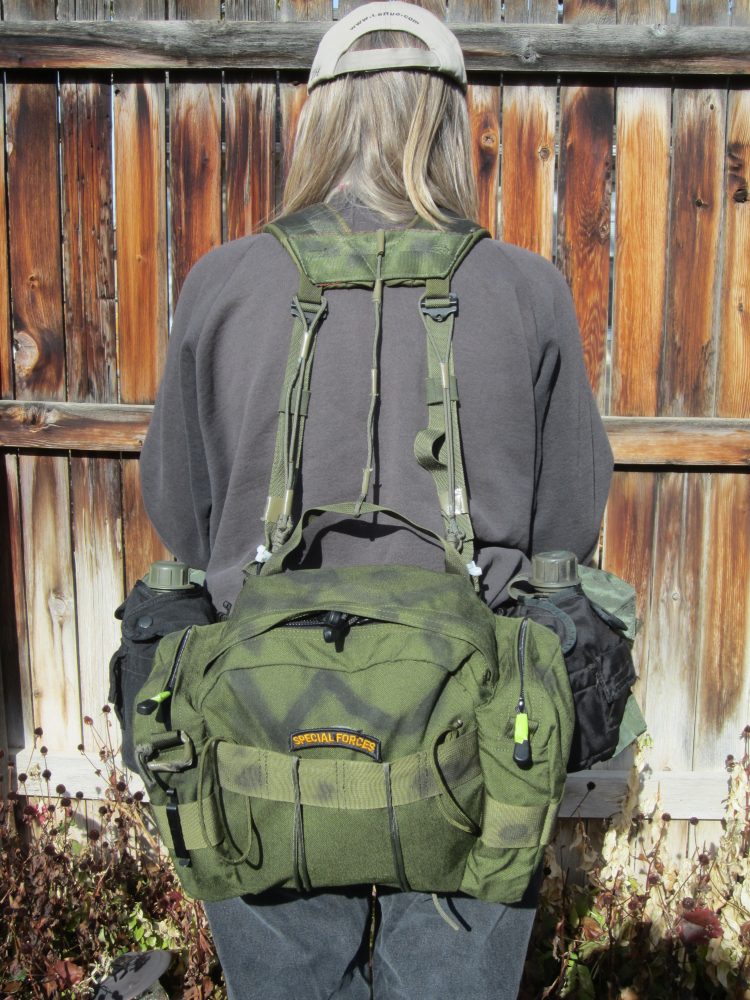
AR PARTS AND ACCESSORIES
Rifle accessories might be a bipod and/or vertical foregrip. If you actually need a Picitanny rail, don’t overdo it. Maybe a laser and/or flashlight, but the batteries will eventually go. Have a decent lightweight sling or carry strap. For ARs I recommend a heavy-duty, easy-to-reach AR charging handle. Bravo Company Mfg’s GUNFIGHTER charging handle is the gold standard.
The AR requires continual maintenance, so have a toothbrush and shaving brush to dust it. For efficiency, I prefer a single-use cleaning and lubing product such as SEAL 1’s stuff—it’s safe and works! Make up a basic cleaning kit and keep it in your pack. Wooden-stock M1As, Garands, SKSs, and AKs have space for cleaning gear in their stocks. And don’t sneer at wooden stocks. They’ve lasted for many decades and will outlast you.
For the more delicate AR, have basic parts such as springs, pins, and gas rings. Have an extra firing pin and broken shell extractor for each of your emergency rifle(s) and keep those with each rifle. The hollow inside of an AR pistol grip is a good place to store extra ear plugs, spare batteries, and other small items. Seal the grip with tape.
STORING AMMO
Ammunition: carry as much as you reasonably can on your person for immediate use (120 rounds of 5.56 or 80 in .30 caliber). Have more in your main pack. Hunting ammunition is especially effective against personnel due to its expansion characteristics and is an instant fight stopper if you can afford some.
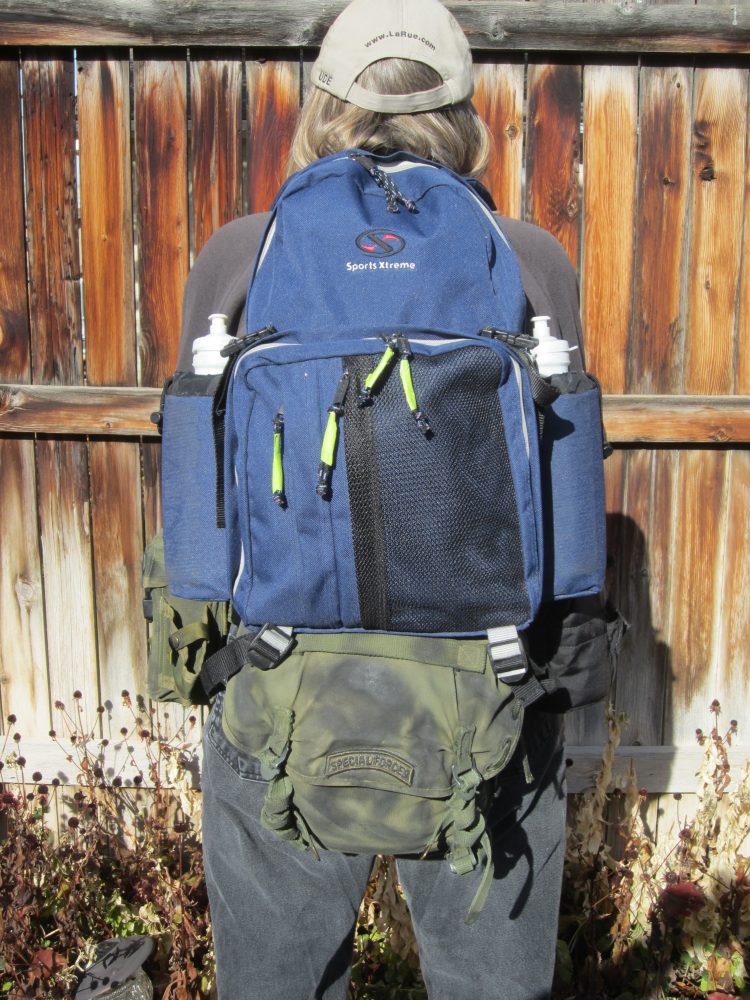
For bulk storage, keep ammunition in smaller 5.56mm and .30-caliber metal ammo cans because they are water and fire resistant, and lighter and easier to carry or pack than the bulkier .50-caliber cans.
Keep stored ammo dry and reasonably cool (under 110 degrees and never in sunlight). Never store your ammunition in any type of bag or container that has an anti-rust firearm-protecting vapor component unless the ammunition is 100% sealed tight from these vapors by a metal barrier such as well-sealed aluminum foil.
Over time, vapors penetrate the bullet mouth area and primer pocket and can seriously degrade the primer. Properly cared for, today’s newer ammunition (military in particular) should be very effective for 80+ years. Cared-for WWII/Korea-era stuff still works fine.
DOOMSDAY RISING
Preparing for a national emergency apocalyptic rattle-battle situation need not be terribly expensive or tough. It’s like buying a fire extinguisher or insurance: a waste of money if you never need it, but if you do need it and don’t have it, the consequences are much worse.
Evaluate your area and scenario, then imagine the worst and plan as best you can. After you solve your basic requirements within reason, you can add other less-necessary items.
And if all of this sounds over the top, remember, “Just because you’re paranoid doesn’t mean they aren’t after you.”
